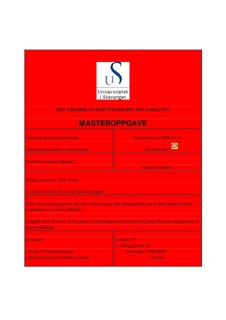| dc.contributor.author | Meidell, Camilla | |
| dc.date.accessioned | 2011-11-08T12:49:45Z | |
| dc.date.available | 2011-11-08T12:49:45Z | |
| dc.date.issued | 2011 | |
| dc.identifier.uri | http://hdl.handle.net/11250/182092 | |
| dc.description | Master's thesis in Risk management | no_NO |
| dc.description.abstract | Project Risk Management (PRM) has in recent years become an important aspect of business
organization and project management. There has always been a requirement for some risk
management at COPNO. However about 3 years ago the process became much more defined and
has become a requirement for the contingency used on projects to be based upon the risking
process. Since risk management in projects is a requirement in the CP organization it is
important that the whole organization understands the benefits of the risk management process.
In this thesis the objective is to review the risk management process in the Capital Projects
organization at ConocoPhillips Norway (COPNO). Weaknesses and strengths will be identified
through comparing the documented project risk management plan and guide at COPNO with
other documented risk frameworks. A review of the definition of risk and the different steps
described in the plan will be done.
The next step in this thesis will be an evaluation of the risk maturity level in the CP organization.
To identify how far the risk management process is implemented at COPNO the Risk
Management Maturity Model (RMMM) will be used. The information will be gathered through
interviews with project managers and review of PRM documents at COPNO.
The RMMM is a staged model describing five levels of process maturity. The model is divided
into 5 maturity levels, each level represents a maturity stage with different criteria which has to
be fulfilled to be categorized at that specific level. The model defines 5 levels of capability and
maturity: 1) Ad- Hoc, 2) Initial 3) Defined 4) Managed 5) Optimized (See figure: 4). Each level
is clearly defined, to enable the organization to evaluate them selves and find the stage they are
at. When the right level is identified, the organization can plan and choose ways or activities of
improving their current status and decide how to achieve the next level. To collect data for the
review of RMM level in interviews of 2 project managers and 1 project controller is done. The
answers form the respondents are compared to the RMM model. After the review level of risk
maturity is classified for each attribute. The classification of risk maturity level is an approach
for identifying areas of improvements. Actions and activities for how the organization can
advance to level 4 are suggested in the discussion section of the thesis. | no_NO |
| dc.language.iso | eng | no_NO |
| dc.publisher | University of Stavanger, Norway | no_NO |
| dc.relation.ispartofseries | Masteroppgave/UIS-TN-IØRP/2009; | |
| dc.subject | risikostyring | no_NO |
| dc.subject | project risk management | no_NO |
| dc.subject | risk management maturity model | no_NO |
| dc.title | Review of the project risk management plan in the capital projects organization at ConocoPhillips | no_NO |
| dc.type | Master thesis | no_NO |
| dc.subject.nsi | VDP::Social science: 200::Economics: 210 | no_NO |
